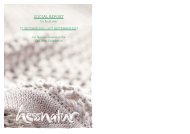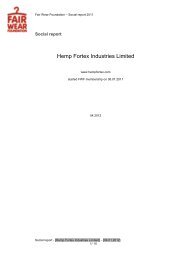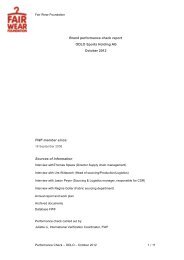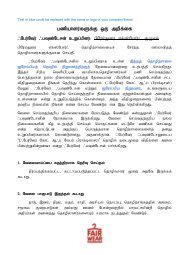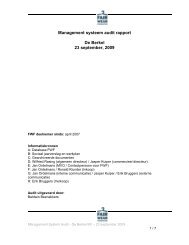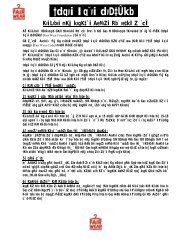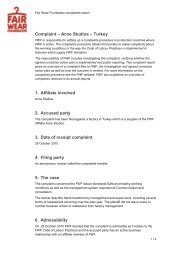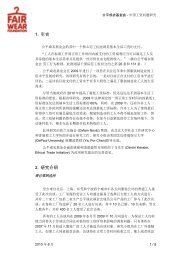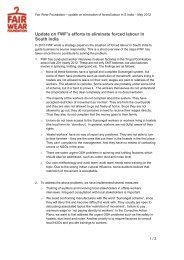Background Study Tirupur - Fair Wear Foundation
Background Study Tirupur - Fair Wear Foundation
Background Study Tirupur - Fair Wear Foundation
Create successful ePaper yourself
Turn your PDF publications into a flip-book with our unique Google optimized e-Paper software.
ence in such regions, or building up supply relationships with key producers who<br />
are already there. IICCI:36<br />
Cawthorne (1995, quoted in Krihsnamoorthy: 54) noted two divergent trends<br />
among the larger firms: either to move way from direct production and concentrate<br />
on the commercial aspects thus adding to the subcontracting model of <strong>Tirupur</strong> or to<br />
integrate all aspects of the production process under one roof, thus establishing a classic<br />
factory model which seems to be a break away from the classic <strong>Tirupur</strong> model. (the large<br />
factory model is prevalent in Bangalore’s garment industry).<br />
2.8. Initiatives to upgrade the industry<br />
In order to encourage garment exports, a centrally sponsored scheme titled Apparel Parks<br />
for Exports Scheme has been launched for setting up of apparel manufacturing units of international<br />
standards at potential growth centres Under this scheme, nine Apparel Parks are<br />
envisaged, at Bangalore (Karnataka), Ludhiana (Punjab), Kanchipuram (Tamil Nadu), Surat<br />
(Gujarat), Thiruvanthapuram (Kerala), <strong>Tirupur</strong> (Tamil Nadu). Tronica City in Kanpur (U.P.)<br />
and Visakhapatnarrt (Andhra Pradesh).<br />
Amongst the important policy measures in the decentralised sector activities covering handloom,<br />
powerloom, sericulture, handicrafts and wool is the adoption of a cluster based approach<br />
in implementation of schemes/programmes in these sectors. (SAARC).<br />
Construction of the apparel park, NAP (Netaji Apparel Park), has started in <strong>Tirupur</strong>.<br />
Under the Apparel Park Scheme, NAP would beget Rs. 10 Cr for common infrastructure, Rs<br />
3 Cr for Effluent treatment plant, building crèches, centres and Rs 2 Cr for setting Training<br />
and R&D centers. TEA has invested money for purchasing the land by spending Rs 4.05 Cr<br />
and would also have a Captive Power Plant. The proposed Apparel park would house most<br />
modern production facilities comparable to those in the developed countries. There will be<br />
eight sheds of 40,000 Sq ft and 45 sheds of 20,000 sq ft, with a provision for vertical expansion.<br />
The Park once it becomes operational would bring in a turnover of Rs 1500 Cr and additional<br />
employment to 21,000 persons.<br />
Shri A Sakthivel, President, TEA and Chairman and Mg Director of NAP urged the State<br />
Government to introduce special labour laws for units that would be set up in the Park.<br />
There are quite some international projects aimed at improving the industry structure in <strong>Tirupur</strong>.<br />
Unido has run a programme in the late 1990’s on SME clusters in India and subsequently:<br />
“UNIDO, with the assistance of the Government of India, picked four pilot clusters—textile<br />
printing in Jaipur, food processing in Pune, knitwear in Ludhiana, and cotton knitwear in <strong>Tirupur</strong>—<br />
to build in each region an institutional infrastructure to “help small firms in the cluster<br />
support themselves.<br />
“UNIDO is now implementing the second stage of its Cluster Program by building working<br />
relationships between small garment exporters from <strong>Tirupur</strong>, one of the chosen clusters, and<br />
cotton knitwear firms in Italy with funding from UNDP and the Italian government.” (Tewari<br />
Goebel 2002)<br />
The Dutch centre for assistance to importers from developing countries CBI runs a project<br />
with some 20 companies in <strong>Tirupur</strong> to prepare them for the post-MFA market. It is called<br />
‘Target 2005’ and aims at improving their market position and management.<br />
The Textile Committee, the programme coordinating body under the Union ministry of textiles<br />
that has a local office in <strong>Tirupur</strong> runs several campaigns, amongst them the national campaign<br />
on quality and compliances in textile and clothing industry. This has three parts:<br />
(a) To sensitize the industry, primarily the (SMEs) in decentralized sector, to the impact of<br />
WTO agreement on Indian textile and clothing industry<br />
(b) To convey an undiluted message that the Indian textile industry, particularly SMEs,<br />
should pay adequate attention to improve the quality of operational processes and the<br />
13



